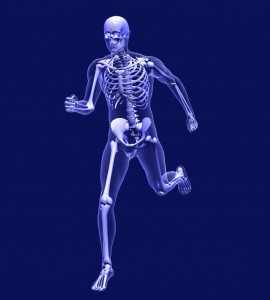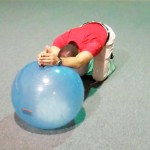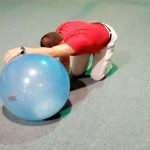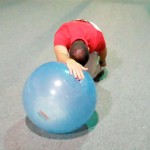Brian Schiff’s Blog
Injury Prevention, Sports Rehab & Performance Training Expert
I utilize bridging as an assessment and exercise tool in my training and rehab programs. Posterior chain/hip stability is poor in many clients. The ability to maintain a neutral spine, engage the glutes and fight rotation is NOT an easy task by any means. So, coaching and cueing proper bridging is a great way to enhance pillar strength and reduce injury risk, while facilitating better movement patterns in sport.
I wrote a recent column for PFP magazine entitled iso bridge with alternate knee extension. Click here to read the column and the application, regression and progression of the exercise. In addition, I have included a short video below showing double leg and single leg bridge exercises that can be used to work on the hips and core. The second exercise is the dynamic version of the iso alternate knee extension bridge I write about. I show you some of the single leg progressions that come after mastering the iso bridge as well.
I hope this video and article is useful to you. I also want to take this opportunity to thank you for reading my blog and wish you a very Happy New Year!
Working with athletes of many disciplines affords me an opportunity to look at many shoulders week to week. Increasingly, I am seeing more Crossfit athletes for various shoulder problems. In many cases, they have rotator cuff tendonitis, impingement, AC joint pain, labral pathology or a combination of the aforementioned issues. The other big group of athletes I see is throwers.
These two groups share many of the same dysfunctions including posterior shoulder tightness and decreased mobility. Tightness in the pecs and lats is commonplace. I feel latissimus tightness often goes unnoticed or perhaps is not an area of emphasis in prehab/rehab plans. Tight lats will restrict elevation and contribute to postural dysfunction.
With restricted elevation, athletes may turn to excessive spinal extension and/or rotation to achieve elevation necessary (e.g. overhead squats, snatches, throwing) and this can contribute to poor movement patterns. I have also seen this impact volleyball players asymmetrically with serving and hitting.
Lat tightness can easily be assessed by placing the athlete supine and simply asking them to bring the arms completely overhead. While most people do not have 180 degrees of flexion, I feel working to achieve elevation greater than or equal to 160 is completely reasonable. The body often uses abduction and external rotation to make things work (and this is natural for throwers), but the more pure elevation capacity we have the the better.
Crossfit involves lots of pull-ups and throwing heavily utilizes the pecs and lats for acceleration. It only follows that muscular tightness in this region may need to be addressed. Step one often involves soft tissue mobilization/compression techniques. I prefer to use a Trigger Point ball or Grid to work on the soft tissue mobilizing it on the wall (TP ball) or floor (Grid) in an elevated position.
Next, I like to employ active mobility work. I recently featured a simple exercise using the BOSU Ballast Ball in my PFP column. The pictures below reveal a rolling double arm version, as well as a single arm method/progression. These active movements can also be complimented by sustained holds as desired.
For a more detailed description and application of this exercise, click here to read my “Functionally Fit” column. I had one Crossfit enthusiast see me for limited shoulder mobility as it was hindering his overhead lifts and causing back pain. He had about 130 degrees of shoulder flexion. Daily STM using the foam roller, mobility work and some stretching increased his elevation by 10 degrees in 2-3 short weeks.
So, the take home message is that overhead athletes should assess and address this limitation if it is present as it may cause kinetic chain issues and energy leaks. Improving mobility will better enable utilization of proper muscle activation and optimal movement patterns.
I had the pleasure of listening to Darin Padua, PhD, of UNC present some of his latest research on ACL injury prevention last week. He has been doing research for some time. One of his studies (JUMP ACL) in collaboration with the military and several others has looked at prospective data and injury occurrence among college age subjects.
Much of the research to date on injury prevention has been done by Timothy Hewett and his colleagues. It has concluded that drop landing with a valgus collapse (hip abduction/IR with valgus knee moment) is a risk factor for injury. Interstingly enough, despite that knowledge and the proliferation of prevention programs, Darin mentioned that overall these prevention programs have not slowed the rate of ACL tears in the last decade. Why is that? He also relayed that much of what we know now is based on 15 total cases.
The Jump ACL Study in a nutshell lasted for 5 years at 3 different military academies:
N = 5,700 cadets with no prior ACL surgery
- Soccer players = 1,690
- Tested from 2005 to 2008
- 39% female; 25% NCAA athletes
- 14,653 person-years of follow-up
N = 113 incident ACL injuries
- Soccer players = 29
- Mean time from testing to injury = 3.1 yrs
- N = 92 one ACL injury; N = 11 two ACL injuries
Some data (will be published) he discussed based on his findings revealed the following about high risk profiles for ACL injury:
- Hip flexion > 40 degrees at landing = 1.76x increased risk
- Hip adduction plus knee valgus = 3x increased risk
- Hip adduction plus knee varus = 27x increased risk
He also mentioned that the high risk profile does not correspond to the ACL injury event profile of:
- Hip abduction
- Lateral trunk flexion
- Knee valgus collapse
- Small knee flexion
- Tibial ER/IR
In the end, he suggests we need to better understand who to target (high risk profile clients) and what to modify (injury event profile) so we can better customize injury prevention programs that optimize proper movement and meet the needs of each individual athlete. He reminded us that using the uninjured side for comparison is insufficient as faulty movement patterns already likely existed contributing to the first ACL injury.
So, assessing movement continuously and striving for excellent movement quality is a MUST if we are going to both prevent initial ACL injuries and reduce the re-tear rates for our athletes we send back to play. He reports that those at increased risk simply have bad biomechanics. His message provides more weight to having an advanced algorithm to identify asymmetry, poor motor control and flawed movement patterns in order to effectively prescribe interventions to address these things.
At UNC they use a PRIME assessment. I am excited to learn more about it and have referred one of my female higher level soccer players to their lab for assessment as I look at this return to play decision with her now that she is just past 7 months post-op. I think the hip/core obviously play an important role as I see so much deficiency in my female patients recovering from injury.
Clearly his findings with hip adduction and varus as a big risk factor seem to indicate it could be a top down kinetic chain breakdown as well upon impact based on the risk profile. Pelvic stability or the lack thereof seems to be significant, only NOT in the same manner we thought about it before based on previous research available. Stay tuned, as we have lots more to learn about ACL injuries and how best to tailor our prevention efforts.
Knowing just when to put an athlete back on the field after ACL reconstruction is a difficult proposition. Surgeons often look at swelling , graft stability and quad girth. In the past, we have relied on isokinetic testing and hop testing measures in the clinic as guidelines as well.
As a sports performance specialist and clinician, I am keenly interested in not only fully rehabbing this injury, but also preventing it form happening again in the future. Observing quality of movement in cutting, jumping, running and drills offers good insight in this process, but I think we need more.

The FMS and Y-Balance test are things I use in my equation as well. I often see clients ace the YBT, but struggle to obtain a passing score on the FMS based on issues in core stability and the deep squat. Current literature reports that any score less than a 14 carries a 4-fold increase for non-contact injury risk in female collegiate athletes. Click here to read that study.
In addition, I look at the following for return to play decision making:
- Single leg squat depth
- Single leg broad jump
- Single leg impact mechanics
- Deceleration and cutting form
- Cross-over hop test
- Single leg triple hop
- 6 M timed hop test
Below is a video of the single leg broad jumps, the triple hop, cross-over hop test and 6 M timed hop test.
What does research have to say? I think we have a vacuum where athletes get “cleared” or released from PT and they wonder back to sport too soon.
Continue reading…
It has been a while since my last post. To be honest, I have been busy with preparing/presenting my live seminar last week and webinars, as well as fulfilling my writing obligations and clinical role. So, I have been taking a “break” from blogging and recharging the battery so to speak.
Now I am getting back to it. The great thing about presenting though is that I am consistently reading and reviewing the latest research on topics related to my presentations and closely examine my rehab and exercise philosophy. In my clinic, I treat many runners for knee pain.

The average profile is an experienced runner b/w the ages of 25 and 50 who logs 20 – 35 miles per week and routinely competes in half marathons or some sort of triathlons.
Common injuries include IT band problems versus lateral meniscus tears versus patellofemoral pain. Often, I uncover the following things related to kinetic chain deficiencies:
- Elevated or rotated inominate
- Ankle dorsiflexion restriction (OH squat assessment)
- Poor single leg stance
- Weak lateral myofascial chain
- TFL dominance
- Excessive femoral internal rotation/adduction with single leg squats
- Tightness in hip flexors, ITB and soleus
Many currently debate the efficacy of foam rolling. Is it worthwhile? Some say yes, while others say no.




